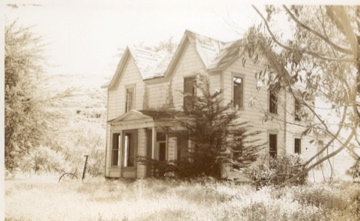A new-old story by June Morrall. [I wrote this in the 1970s when I was first learning about the fascinating Coastside. Most of my research was done at the San Mateo County History Center, then located on the campus of the College of San Mateo.]
The Corral de Tierra
Festive rodeos lasting several days were commonplace around Miramar Beach in the 1840s, the mid-19th century, pre-Gold Rush, pre-Mexican-American War.
Accompanied by merry-making and feasting, the round-ups included scores of rancheros, the Spanish/Mexican grantees to huge numbers of acreage, and the skilled performance of their “vaqueros,” or cowboys. These were special, exciting occasions where spirited competition among the vaqueros took center stage as they showed off their excellent horsemanship and remarkable use of the la reata, or the handling of ropes.
The grantee to the Corral de Tierra was Tiburcio Vasquez, among whose kids was Pablo, later considered “Coastside royalty,” and whose home stood near the quaint concrete bridge in Half Moon Bay.
Cattle picked for later slaughter were lassoed by the vaqueros; brought down and burned with the owner’s steaming hot brand. The other animals were released, allowed to roam freely for another year on the Corral de Tierra—-encompassing the present-day communities of Montara, Moss Beach, El Granada , Miramar, stretching all the way to Pilarcitos Creek in Half Moon Bay. The land was called the Corral de Tierra because its natural shape resembled that of an earthen corral or natural enclosure.
Up until 1840, Mission Dolores in San Francisco used the land for grazing. Our Coastside was an isolated territory, cut off from “civilization” by mountainous barriers, making it difficult for families and large amounts of belongings to relocate there. At the time the hills concealed a considerable mountain lion and grizzly bear population.
The Corral de Tierra was divided into two Spanish/Mexican land grants. Tiburcio Vasquez (the uncle of a notorious bandit with the identical name who was hanged in San Jose in the mid-187os) ran 2100 head of cattle and some 200 beautiful horses on his 4, 436-acre rancho. Tiburcio, the land grantee, had been supervisor of the Mission Dolores livestock when he applied and received the southern portion of the Corral de Tierra.
That left the northern 7,766-acres to Francisco Guerrero, who had held many positions throughout his official career in San Francisco. The dividing line between the two ranchos was the Arroyo de en Medio Creek the Ocean Shore Railroad-named Miramar.
Guerrero built a ranch home known as the “Guerrero Adobe,” on a hillside near a creek about one mile northeast of Princeton.
[Image of the Guerrero House, which also became Charlie Nye’s first hotel.]

Until the 1906 earthquake and fire, the house was still in fair condition, including four rooms on the ground floor with an attic above. A porch surrounded the entire front of the home.
It is said that Tiburcio built the first adobe in Half Moon Bay, then known as Spanishtown. The adobe had five rooms and stood on the north bank of the Pilarcitos Creek, northwest of the concrete bridge. (Yes, that confuses me, too.)
As I mentioned above, Pablo, the Vasquez’s youngest son who lived into the early 20th century, built a frame house that is still standing near the bridge. He opened up a successful livery business–but when the barn deteriorated over the years it was finally demolished on February 18, 1977.
Francisco Guerrero, the other land grantee, and a man with many jealous enemies, continued to spend a great deal of his time in less isolated San Francisco. In 1850 he was murdered as he stood near the corner of Mission and 12th Streets. The fatal injury occurred when a mysterious man on horseback struck him about the head with a slingshot.
And on April 12, 1863, as Tiburcio Vasquez sat near a window in a Spanishtown saloon, a volley of gunshots rang out. When the dust settled, Vasquez was found dead—and the elusive murderer long gone.
According to informed observers, both Vasquez and Guerrero were significant witnesses in the “famous” Santillian land fraud case. Some speculate that this connection led to both their murders.
